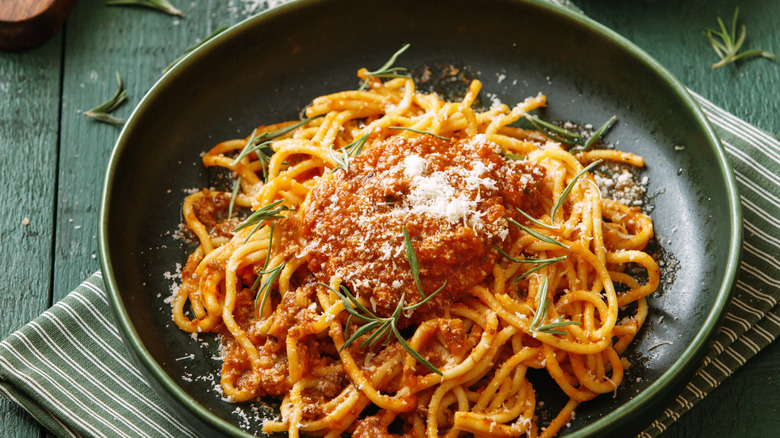The Most Common Mistake People Make When Cooking Marinara Sauce
Making your own marinara sauce at home isn't as hard as you think. In fact, if you're working hard, you're probably doing something wrong.
Tomato sauces inspire a certain kind of romantic imagery. It calls to mind some Italian grandmother in an apron dicing garlic, and carefully watching over a sauce as it simmers throughout the day until it's become a deeply fragrant and flavored sauce. Those types of sauces exist, but that doesn't include marinara sauce, as it doesn't take that much labor to create a delicious sauce for pasta, pizza, or dipping.
One of the most common mistakes made when cooking marinara sauce is overcooking. A classic marinara should actually be a simple, bright, and tomato-forward sauce with a few notes of garlic or basil added at the last moment. This doesn't come from slaving over a simmering pot all day. Instead, all it takes is lightly cooking down puréed tomatoes until the sauce has thickened slightly.
How to make a true marinara sauce
The best way to make a good marinara sauce is to start with the best tomatoes. When made correctly, a good marinara should be an expression of your tomatoes, and so using something that has high acidity or excess amounts of water can detract from this.
Instead, use plum tomatoes — San Marzano especially if you can find them. Plum tomatoes have a pleasant sweetness, fewer seeds, and less water than other kinds of tomatoes which means that they make a thicker paste when pureed. Canned whole tomatoes that you purée yourself work well, but the puréed kind will work just as well. Because the marinara isn't getting a long cooking time though, there isn't a lot of time for large chunks to break down, so make sure that the consistency is close to where you want the final sauce to be.
Then, just add the purée to a pan and cook it over medium-high heat for five to 10 minutes while stirring frequently. This should be more than enough to roast the tomatoes and bring out their potential without burning them. You can let them go longer, but anything over 20 minutes will be more akin to a different kind of tomato sauce.
Differences between marinara and other tomato sauces
A marinara sauce is great for all sorts of culinary uses, but it does have qualities that separate it from other tomato sauces.
For example, a more traditional pizza sauce is often only a raw tomato purée that might have some additional flavoring. It usually has a thicker consistency than a marinara or pasta sauce because it has tomato paste added as well. This consistency helps it adhere better to the dough and ingredients, however, and the quick cooking time will make sure that the same bright flavors of a marinara are able to develop. Of course, you can still use a marinara sauce to top a pizza, but the lighter consistency and increased time cooking may change the end result slightly.
Marinara sauce can also be used for pasta, but if you want to make a rich meat sauce like a bolognese or what some might know as a "Sunday Gravy," then the slower cooking time will be more appropriate. This style of sauce is more often served with rich meats because the complex flavors pair well with fatty cuts of beef or pork. The French approach to this, known as sauce tomate, even begins with a roux to ensure a thicker consistency. It will also have more additional ingredients, and often several cuts of meat. These are the main differences between marinara and tomato sauces.


